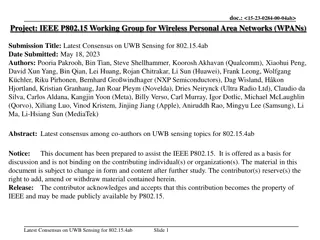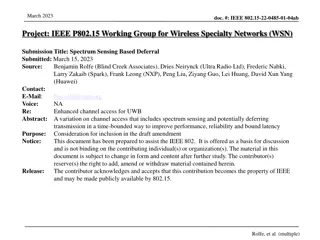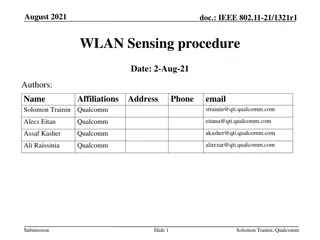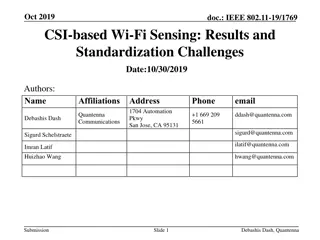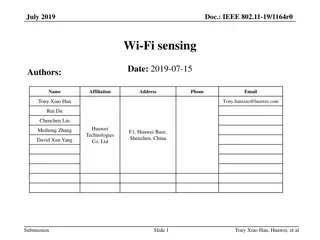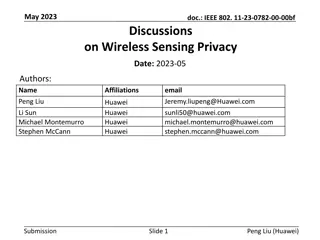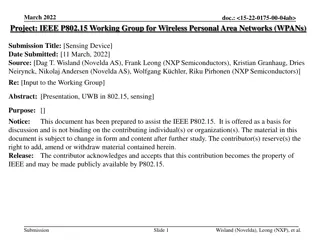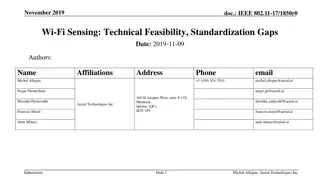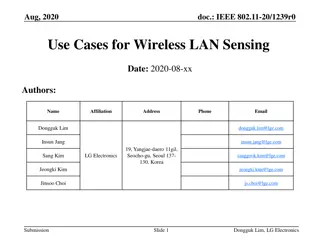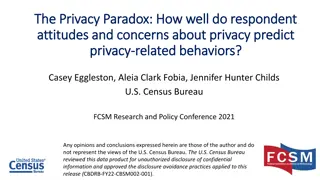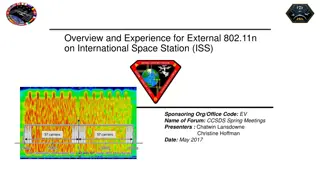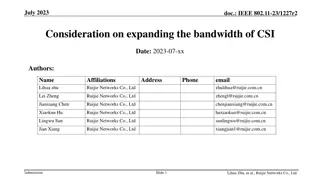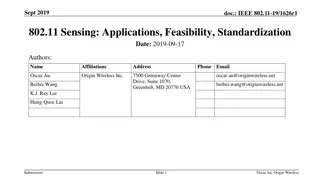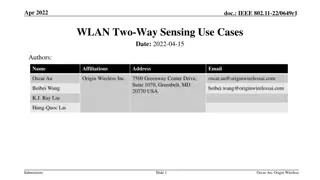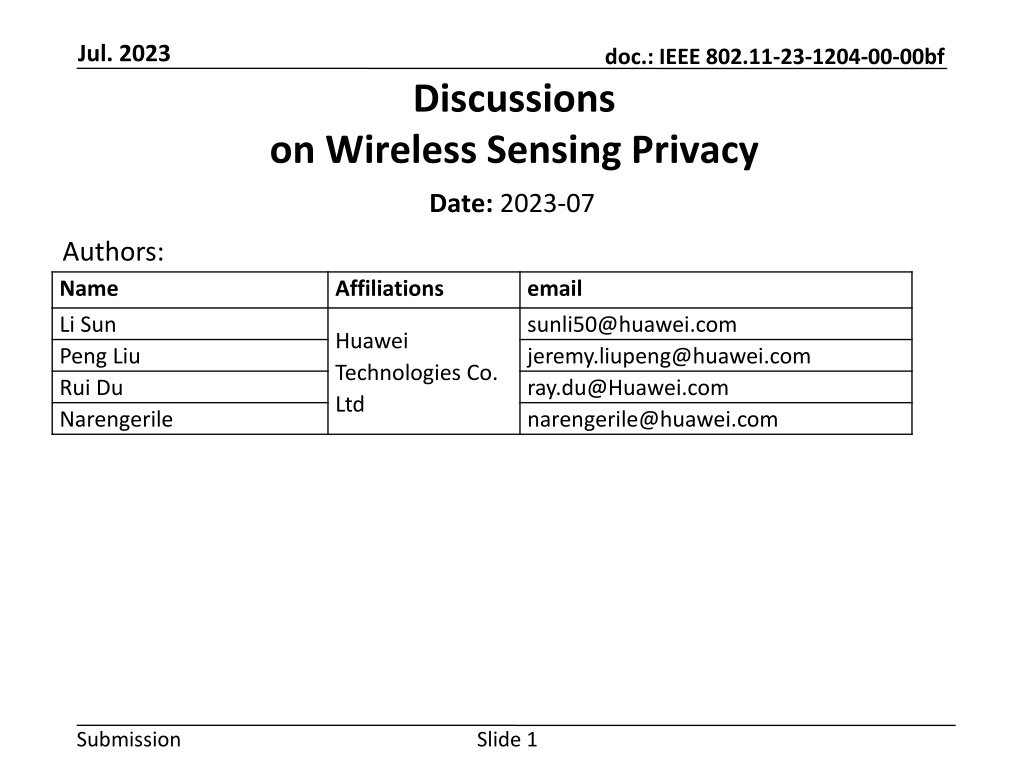
Wireless Sensing Privacy Challenges and Solutions
Explore the privacy issues in wireless sensing technology, covering topics such as unauthorized data interception, device tracking, and personal information extraction. Learn about potential risks and solutions to secure sensitive information exchanged during wireless communication.
Download Presentation

Please find below an Image/Link to download the presentation.
The content on the website is provided AS IS for your information and personal use only. It may not be sold, licensed, or shared on other websites without obtaining consent from the author. If you encounter any issues during the download, it is possible that the publisher has removed the file from their server.
You are allowed to download the files provided on this website for personal or commercial use, subject to the condition that they are used lawfully. All files are the property of their respective owners.
The content on the website is provided AS IS for your information and personal use only. It may not be sold, licensed, or shared on other websites without obtaining consent from the author.
E N D
Presentation Transcript
Jul. 2023 doc.: IEEE 802.11-23-1204-00-00bf Discussions on Wireless Sensing Privacy Date: 2023-07 Authors: Name Affiliations email Li Sun Peng Liu Rui Du Narengerile sunli50@huawei.com jeremy.liupeng@huawei.com ray.du@Huawei.com narengerile@huawei.com Huawei Technologies Co. Ltd Submission Slide 1
Jul. 2023 doc.: IEEE 802.11-23-1204-00-00bf Outline Wireless sensing privacy issues Discussions within other SDOs 3GPP (Release 19) IEEE 802.11 bi IEEE 802.15.4ab (NG-UWB) Submission Slide 2
Jul. 2023 doc.: IEEE 802.11-23-1204-00-00bf Three Privacy Issues in Wireless Sensing Issue #1: The sensing report (or the sensing result) exchanged between the initiator and the responder can be overheard by an unauthorized device or a malicious user, which causes sensitive/private information leakage [1]. This issue is essentially about the confidentiality of the sensing results, which can be easily dealt with by using the existing encryption methods. Also, this is not a unique problem associated with sensing. The attacker can overhear any data transmission as well. Submission Slide 3
Jul. 2023 doc.: IEEE 802.11-23-1204-00-00bf Three Privacy Issues in Wireless Sensing Issue #2: The attacker overhears the wireless transmissions between sensing initiator and sensing responder, from which it can identify and track the sensing devices [2]. This issue relates to privacy (more precisely, the privacy of the devices performing sensing), but this is not a unique problem in sensing. For data communications scenario, the attacker is able to identify and track the devices by intercepting the wireless transmission as well. Submission Slide 4
Jul. 2023 doc.: IEEE 802.11-23-1204-00-00bf Three Privacy Issues in Wireless Sensing Issue #3: Sensing signal from the transmitter can be overheard by an eavesdropper, who will perform channel estimation and extract personal/private information (e.g., the heart rate, respiratory rate, location, etc.) based on his own collected CSIs. This issue relates to the privacy of the objects (or individuals) being sensed, and we may take into account this issue in the Wi-Fi sensing group. Submission Slide 5
Jul. 2023 doc.: IEEE 802.11-23-1204-00-00bf More on Issue #3 A transmitter (Tx) is a device (e.g., a Wi-Fi access point) that transmits sensing signals at home. The eavesdropper (i.e., a passive observer) can sniff the wireless signals to extract private information about the objects (e.g., the person) being sensed. Respiratory rate estimation and presence inference [5] Walking pattern inference [3] Behavior and identification inference [4] Private information include locations, living habits, behavioral biometric characteristics, heart rate, respiratory rate, and even the identification. Submission Slide 6
Jul. 2023 doc.: IEEE 802.11-23-1204-00-00bf More on Issue #3 One may concern that even without sensing, a passive observer can still monitor wireless signals coming from a home and extract information about people s locations or behaviors. However, to extract useful information about a person or the environment, a series of continuously-varying CSI measurements are required to be collected. Wireless sensing provides an opportunity for the eavesdropper to continuously perform channel estimation because a sensing session typically consists of several rounds, which last for a long time. In contrast, for regular communications, the preambles are not transmitted continuously. So, it would be rather difficult for the eavesdropper to collect a series of continuously-varying CSIs. In this sense, Issue #3 is a unique one for sensing. Submission Slide 7
Jul. 2023 doc.: IEEE 802.11-23-1204-00-00bf More on Issue #3 One may also concern that the attacker (3rd party) can simply send bogus/spoof frames (RTS/QoS-Null) to cause transmission of ACK/CTS frames from the sensing devices to measure the channel. However, the attacker assumed in this scenario is an active attacker who transmits signals. There are many approaches to detect active attackers or to identify whether or not the frames are from the legitimate node. Nevertheless, the Issue #3 mentioned above considers a passive attacker who never transmits signals but only eavesdrops on the transmissions. So, Issue #3 is more difficult to be dealt with. Submission Slide 8
Jul. 2023 doc.: IEEE 802.11-23-1204-00-00bf Passive vs. Active Attacks Passive attack Active attack Attack model (i.e., attacker s behavior) The attacker simply eavesdrops on the sensing signals from the transmitter, based on which the CSI is estimated and the information related to the sensed target can be obtained The attacker sends spoof frames (e.g., probe requests) to cause transmission of response frames from the sensing devices to measure the channel Privacy leakage Yes Yes Yes1 Unique issue in sensing No The cost of launching the attack Low (Any receiver within the coverage of the legitimate transmitter can do this) High (firmware may be modified to send probe frames continuously, MAC address needs to be falsified, etc.) Countermeasures TBD Attacker detection & identification, Application layer techniques2 Note 1: In data communication scenarios, the preambles are not transmitted continuously. Therefore, it would be rather difficult for the eavesdropper to collect a series of continuously-varying CSIs, which is required for many sensing applications. Besides, data communications typically use beamforming techniques, thus presenting eavesdropping if the attacker is not in the beam direction. Note 2: Attacker detection & identification can be realized based on MAC address, the location of the device, or using radio fingerprinting techniques. Alternatively, application layer techniques can also be used (e.g., decides to reject/accept the probe request frames). Submission Slide 9
Jul. 2023 doc.: IEEE 802.11-23-1204-00-00bf Related bf Contributions Issue #1 was discussed in [1] (11-22/0099r0), where it was proposed that AP should control access of sensing measurements (e.g., CSI) for the sake of privacy protection. Issue #2 was pointed out In [2] (11-22/0401r4), where it was suggested that the tracking of sensing STAs should be prevented to protect users privacy. While all these three issues are related to privacy, we focus on Issue #3 in this contribution, which is a unique problem incurred by wireless sensing and has not be addressed in TGbf. Submission Slide 10
Jul. 2023 doc.: IEEE 802.11-23-1204-00-00bf Discussions within other SDOs 3GPP (Release 19) o In [5, Sect. 5.16], it was stated that the 5G system shall provide a mechanism to protect identifiable information that can be derived from the sensing measurements data from eavesdropping. o In [5, Sect. 6], it was further declared that: With sensing technology by-standers can be affected in a completely new way, previously only UEs have been able to be tracked but now sensing capabilities may enable tracing and potentially identification of anything in the environment, including humans that do not carry a UE, or any objects. This has implications for privacy. Since Sensing is almost for the whole environment under the RF signal coverage, the privacy of sensing operation is an important consideration factor for real deployment. IEEE 802.11bi (Enhanced Service with Data Privacy Protection) o In [6], it was stated that 11bi shall define a mechanism to protect transmitted sensing measurement frames against eavesdropper sensing estimations. IEEE 802.15.4ab (NG-UWB) o In [7], it was pointed out that by listening to legitimate transmissions and estimating the CSI, the unauthorized parties can infer the presence and locations of the objects, analyze the behaviors of users, and do environmental mapping, which incurs privacy concerns. o In [8], a collaborative sensing method was proposed to prevent the unauthorized users deciphering the CSI from its received sensing packets. Submission Slide 11
Jul. 2023 doc.: IEEE 802.11-23-1204-00-00bf References [1] 11-22-0099-00-00bf-wlan-sensing-privacy-use-cases, Jan. 2022. [2] 11-22-0401-04-00bf-sensing-security-requirements, Apr. 2022. [3] W. Sun, T. Chen, and N. Gong, SoK: Inference attacks and defenses in human-centered wireless sensing, available online, https://arxiv.org/abs/2211.12087, Nov. 2022. [4] J. Liu, C. Xiao, K. Cui, J. Han, X. Xu, and K. Ren Behavior privacy preserving in RF sensing, IEEE Trans. Dependable and Secure Computing, vol. 20, no. 1, pp. 784-796, Jan. 2023. [5] 3GPP TR 22.837, Feasibility Study on Integrated Sensing and Communication, Nov. 2022. [6] F. Zhang, C. Chen, B. Wang and K. J. R. Liu, Wispeed: A statistical electromagnetic approach for device-free indoor speed estimation, IEEE Internet Things J., vol. 5, no. 3, pp. 2163-2177, Jun. 2018. [7] 15-22-0177-01-04ab-privacy-issues-in-uwb-sensing, Mar. 2022. [8] 15-22-0248-00-04ab-privacy-preserving-and-performance-enhancement-for-uwb-sensing, May 2022. Peg Liu (Huawei) Submission Slide 12


